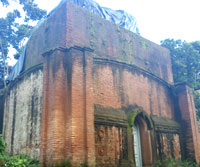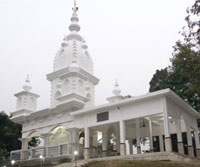Naba Ratna Mandir of Gobinda Dev

It is a large and magnificient temple at Ichhapur-I Gram Panchayat, dedicated to Govindajee, the household deity of Raghunath Chakraborty Chatudhurin, who was a powerful landlord of the area in the seventeenth century. The temple was built between 1655-1675 A.D. The deserted and partially collapsed temple of Ichhapur, still looking massive and high, stands as a witness of the power and affluence of the Har Chowdhury family of Ichhapur. The architect of the temple was a muslim named ‘Alan Baks’, an inhabitant of Dacca, who was invited by Raghav, King of Nadia and a friend of Raghunath. Alan Baks was a noted architect whose fame spread as far as Nadia. The jod-bangla temple, nat mandir and dol mancha no longer exist. The existing ruin represents the navaratna temple. But now no tower or ratna exists. The temple was once profusely decorated with beautiful terracotta works. But the local visitors have robbed the temple of its ornamental bricks. The black stone image of Govindaji is still worshipped in a dalan mandir nearby.
Connectivity : To avail any bus heading towards Barasat from Gaighata B.D.O. office through 36 National Highway, and to get down at Gaighata Bus Stop.

Worship of Lord Shiva started during the reign of ‘Sen Rajas’ in the eighteenth century. It is believed that Kashinath Roy, ruler of Krishnanagar first started the worship of Lord Shiva here. Raja Krishnachandra Roy had a palace in the adjacent Chandigarh mouza. This area has now turned into a big water body. In the year 1983-84, historian Nishit Ranjan Ray surveyed the area and reported that Jaleswar and the surrounding areas were Buddhist Villages and that three elevated areas in Shibpota, Bhogpota and Mangalpota were ruins of Buddhist Temples. Later on the worshippers of shiva started worship on these elevated lands. It is believed that worship of shiva started 800 to 850 years before the construction of this temple. This temple is situated in mouza no.22, mouza name Jaleswar, dag no. 2083, kathian no. 1 and had an area of 1 acre and 16 satak. Later on, Ramesh Ch. Bandopadhyay, zaminder of Gobordanga donated 20 acres land for the temple. The temple committee comprised of people of Jaleswar and its surrounding villages. The temple consists of 2 shiva temples and 1 kali temple. In front of the temple, there is a pond named “shiv pukur” covering an area of 4 acres and 40 satak. It is said that due to the fear of vandals, priests used to hide the image of shiva in this pond just after the “chaitra gajan”. For this reason, this shiva is also known as “buro shiva”. And because the god image of this area was kept immersed in water, this mouza was named “Jaleswar”.
Connectivity :To avail Thakurnagar-Jaguli bus from Thakurnagar Railway Station, and to get down at Jaleswar Shib Mandir Bus Stop.
